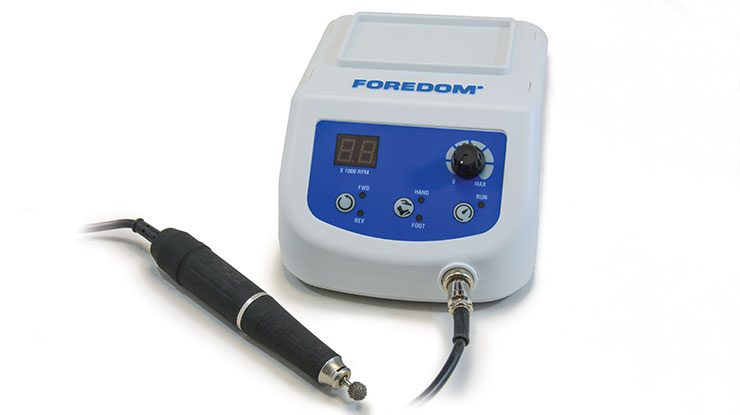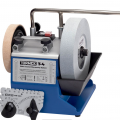The new Foredom K.1060 delivers both power and precision—at a friendly price
By Editors of Woodcarving Illustrated
$579 at Foredom.net or check your local woodcarving supplier
Most power carvers use flexible shaft tools to make rough cuts and then add fine detail using micromotors with small bits, units that combine a comfortable handpiece with power supply and speed control. But at $579, Foredom’s new K.1060 Brushless Micromotor is something special—not only is it perfect for intricate carving, it’s powerful enough to handle heavier-duty work with ease. In fact, with this tool and an assortment of bits, I can carve any project under 8″ (20.3cm) from start to finish, all for a price that beats anything on the market.
Flexible Shaft vs. MicromotorFlexible shaft tools are powerful. They can rip through wood at an astonishing rate. But most of them max out at 15,000 to 20,000 rpm, and the bits you generally use to add details, such as diamond and ruby, work better at higher speeds. That’s why most carvers switch to micromotors, which can reach speeds of 50,000 rpm, for intricate work. And while flexible shaft tools are fine for larger projects clamped securely to a bench, I find them too powerful for smaller pieces that need to be handheld. Using one, I find myself bracing against the bench and tightening my wrist muscles to withstand the power of the tool. I’m constantly adjusting my position to keep from bending the shaft too sharply, which makes the handpiece jerk around. Micromotors, conversely, are less powerful but offer better speed and comfort. The handpiece connects to the power supply with a soft, flexible cord, and is easy to hold at all speeds. (I grip it in a fist when roughing out with carbide-point bits, and hold it like a pencil to carve fine detail.) They are powered in one of two ways, by brushed or brushless motors. Because of how they are constructed, the brushless ones are noticeably more powerful (they tend to last longer, too). The rub is that they cost significantly more: brushed units start at $200, while brushless versions start at around $700. That’s where Foredom’s new brushless micromotor comes in—it lists for less than $600. And while you might expect that that price comes at the expense of other desirable attributes, the opposite is true: the K.1060 revs to 50,000 rpm and is one of the most user-friendly micromotors I’ve ever worked with. |
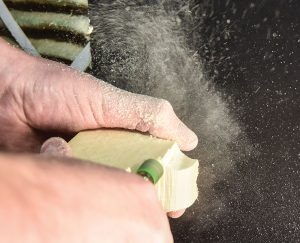
Chuck in an aggressive carbide-point bit to remove waste wood in a hurry. |
More Power = Faster Wood RemovalTo test the Foredom, I first put an aggressive carbide-point bit in a brushed micromotor and dug into a piece of oak. I couldn’t press very hard before the bit bogged down and the motor stalled. With the K.1060, I had to apply a great deal more pressure to get the tool to stall, and it tore through the hard oak much faster. Not as fast as a flexible shaft tool, perhaps, but plenty fast for my purposes. |
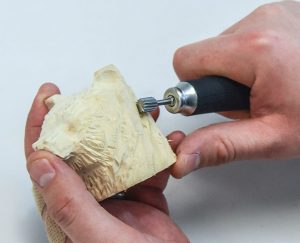
With a finer bit, like this fluted cylinder, you can carve fur flow and texture. |
Digital Readout = Safer, Easier UseWhere most other micromotors have rough speed marks on the control dial, the Foredom has a precise digital readout, making it safer because you can make sure you’re not exceeding the bit manufacturer’s maximum allowed speed. Moreover, once you dial in a comfortable speed for different bits, you can easily return to that speed after changing them. HandpieceThe K.1060’s quick-change handpiece accommodates bits with 3/32″ (2.4mm) and 1/8″ (3mm)-diameter shafts. Bit changes take seconds, and the collets grip well. As noted, the handpiece is comfortable to hold and the power cord is flexible and easy to maneuver. |
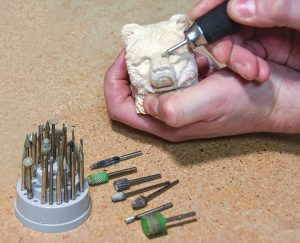
Even finer bits, like this inverted cone (right), add more intricate detail. Below: a sample of bits the K.1060 can handle. |
WorkabilityPower carver Lori Andrews creates most of her projects—including the bear on our cover—using flexible shaft tools. I duplicated her project using just the Foredom. While I had to substitute a smaller carbide-point bit—Lori uses a large cylinder-shaped one with a 1/4″ (6mm)-diameter shaft—I was able to carve the bear in a similar amount of time, quickly and easily. In fact, I prefer the high-speed tool for adding the fur details because it allowed me to take light, quick cuts. Overall OpinionIf you already have and regularly use a flexible shaft tool, you may not need a micromotor this powerful. But if you’re looking to start power carving, especially if you’re having trouble using edged tools, I highly recommend this bad boy. For most of my power carving, it’s now the only tool I use. |
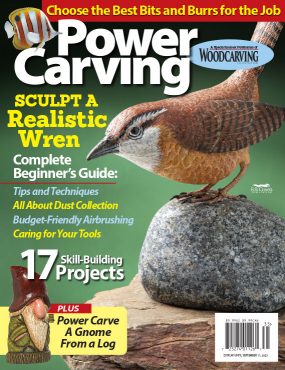 |
Get the Power Carving Manual 2023 Issue Purchase the IssueFor more articles like this, subscribe to Woodcarving Illustrated magazine. Magazine SubscriptionPlus! Get digital mini magazines in your e-mail between printed issues.
|


